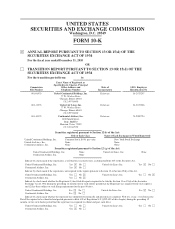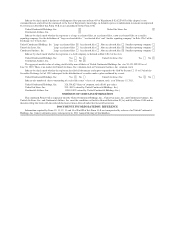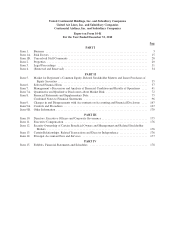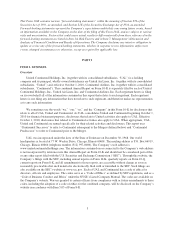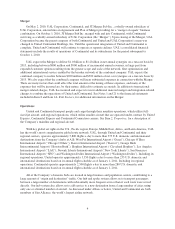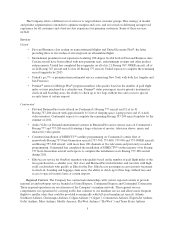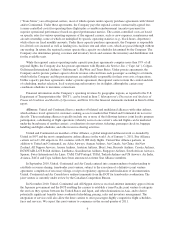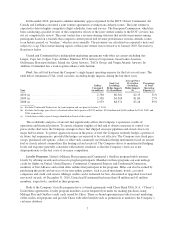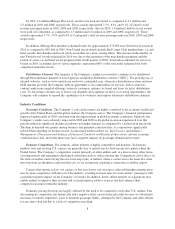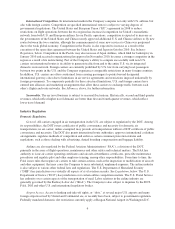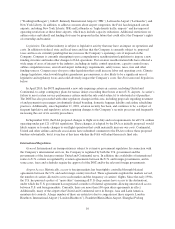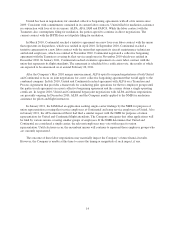United Airlines 2010 Annual Report Download - page 6
Download and view the complete annual report
Please find page 6 of the 2010 United Airlines annual report below. You can navigate through the pages in the report by either clicking on the pages listed below, or by using the keyword search tool below to find specific information within the annual report.Merger
On May 2, 2010, UAL Corporation, Continental, and JT Merger Sub Inc., a wholly-owned subsidiary of
UAL Corporation, entered into an Agreement and Plan of Merger providing for a “merger of equals” business
combination. On October 1, 2010, JT Merger Sub Inc. merged with and into Continental, with Continental
surviving as a wholly-owned subsidiary of UAL Corporation (the “Merger”). Upon closing of the Merger, UAL
Corporation became the parent company of both Continental and United and UAL Corporation’s name was
changed to United Continental Holdings, Inc. Until the operational integration of United and Continental is
complete, United and Continental will continue to operate as separate airlines. UAL’s consolidated financial
statements include the results of operations of Continental and its subsidiaries for the period subsequent to
October 1, 2010.
UAL expects the Merger to deliver $1.0 billion to $1.2 billion in net annual synergies on a run-rate basis by
2013, including between $800 million and $900 million of incremental annual revenues, in large part from
expanded customer options resulting from the greater scope and scale of the network, fleet optimization and
additional international service enabled by the broader network of the combined company. UAL expects the
combined company to realize between $200 million and $300 million of net cost synergies on a run-rate basis by
2013. We also expect that the combined company will incur substantial expenses in connection with the Merger.
There are many factors that could affect the total amount or the timing of those expenses, and many of the
expenses that will be incurred are, by their nature, difficult to estimate accurately. In addition to transactional
merger-related charges, UAL has incurred and expects to incur additional material merger and integration-related
charges to combine the operations of United and Continental. See Notes 1 and 21 to the financial statements
included in Item 8 and Item 1A, Risk Factors, for additional information on the Merger.
Operations
United and Continental transport people and cargo through their mainline operations, which utilize full-
sized jet aircraft, and regional operations, which utilize smaller aircraft that are operated under contract by United
Express, Continental Express and Continental Connection carriers. See Item 2, Properties, for a description of
the Company’s mainline and regional aircraft.
With key global air rights in the U.S., Pacific region, Europe, Middle East, Africa, and Latin America, UAL
has the world’s most comprehensive global route network. UAL, through United and Continental and their
regional carriers, operates approximately 5,800 flights a day to more than 375 U.S. domestic and international
destinations from the Company’s hubs at A.B. Won Pat International Airport (“Guam”), Chicago O’Hare
International Airport (“Chicago O’Hare”), Denver International Airport (“Denver”), George Bush
Intercontinental Airport (“Houston Bush”), Hopkins International Airport (“Cleveland Hopkins”), Los Angeles
International Airport (“LAX”), Newark Liberty International Airport (“New York Liberty”), San Francisco
International Airport (“SFO”) and Washington Dulles International Airport (“Washington Dulles”). Including its
regional operations, United operates approximately 3,350 flights a day to more than 235 U.S. domestic and
international destinations based on its annual flight schedule as of January 1, 2011. Including its regional
operations, Continental operates approximately 2,500 flights a day to more than 280 U.S. domestic and
international destinations based on its annual flight schedule as of January 1, 2011.
All of the Company’s domestic hubs are located in large business and population centers, contributing to a
large amount of “origin and destination” traffic. Our hub and spoke system allows us to transport passengers
between a large number of destinations with substantially more frequent service than if each route were served
directly. Our hub system also allows us to add service to a new destination from a large number of cities using
only one or a limited number of aircraft. As discussed under Alliances below, United and Continental are both
members of Star Alliance, the world’s largest airline network.
4

